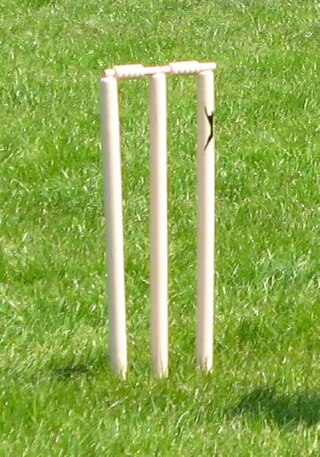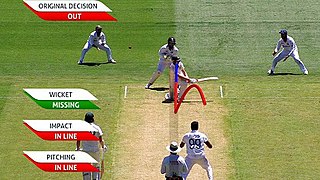
Leg before wicket (lbw) is one of the ways in which a batter can be dismissed in the sport of cricket. Following an appeal by the fielding side, the umpire may rule a batter out lbw if the ball would have struck the wicket but was instead intercepted by any part of the batsman's body. The umpire's decision will depend on a number of criteria, including where the ball pitched, whether the ball hit in line with the wickets, the ball's expected future trajectory after hitting the batsman, and whether the batsman was attempting to hit the ball.
The Laws of Cricket is a code that specifies the rules of the game of cricket worldwide. The earliest known code was drafted in 1744. Since 1788, the code has been owned and maintained by the private Marylebone Cricket Club (MCC) in Lord's Cricket Ground, London. There are currently 42 Laws, which describe all aspects of how the game is to be played. MCC has re-coded the Laws six times, each with interim revisions that produce more than one edition. The most recent code, the seventh, was released in October 2017; its 3rd edition came into force on 1 October 2022.

The wicket-keeper in the sport of cricket is the player on the fielding side who stands behind the wicket or stumps being watchful of the batsman and ready to take a catch, stump the batsman out and run out a batsman when occasion arises. The wicket-keeper is the only member of the fielding side permitted to wear gloves and external leg guards. The role of the keeper is governed by Law 27 and of the Laws of Cricket.

In cricket, the term wicket has several meanings:

This is a general glossary of the terminology used in the sport of cricket. Where words in a sentence are also defined elsewhere in this article, they appear in italics. Certain aspects of cricket terminology are explained in more detail in cricket statistics and the naming of fielding positions is explained at fielding (cricket).

In cricket, a dismissal occurs when a batter's innings is brought to an end by the opposing team. Other terms used are the batter being out, the batting side losing a wicket, and the fielding side taking a wicket. The ball becomes dead, and the dismissed batter must leave the field of play for the rest of their team's innings, to be replaced by a team-mate. A team's innings ends if ten of the eleven team members are dismissed. Players bat in pairs so, when only one batter remains who can be not out, it is not possible for the team to bat any longer. This is known as dismissing or bowling out the batting team, who are said to be all out.
Obstructing the field is one of the nine methods of dismissing a batsman in the sport of cricket. Either batsman can be given out if he wilfully attempts to obstruct or distract the fielding side by word or action. It is Law 37 of the Laws of cricket, and is a rare way for a batsman to be dismissed; in the history of cricket, there has been only two instances in Test matches, six occasions in One Day International (ODI) games, and only one instance in Twenty20 International matches. There have also been seven instances in Test cricket, and two in ODIs, where a batsman has been dismissed handled the ball, a mode of dismissal now folded into obstructing the field.
Hit the ball twice, or "double-hit", is a method of dismissal in the sport of cricket. Its occurrence in modern cricket is exceptionally rare.
Timed out is a method of dismissal in the sport of cricket. It occurs when an incoming batter is not ready to play within a given amount of time of the previous batter being either dismissed or retired. This is one case of a 'diamond' or 'platinum' duck, as the player is out without having faced a ball. Only one batter in international cricket has been dismissed by this method, Angelo Mathews playing against Bangladesh in the ICC Men's Cricket World Cup 2023. The purpose of the law is to ensure there are no unnecessary delays to the game. It is easily avoided, and it is very unusual for a batter to get out 'timed out'. As of December 2023, there have been no instances of this type of dismissal in Test match or Twenty20 cricket, a single instance in one day international cricket, and six instances in first-class cricket as a whole.

In cricket, the term bowled has several meanings. First, it is the act of propelling the ball towards the wicket defended by a batter.

Caught is a method of dismissing a batsman in cricket. A batsman is out caught if the batsman hits the ball, from a legitimate delivery, with the bat, and the ball is caught by the bowler or a fielder before it hits the ground.

Run out is a method of dismissal in cricket, governed by Law 38 of the Laws of Cricket. A run out usually occurs when the batters are attempting to run between the wickets, and the fielding team succeed in getting the ball to one wicket before a batter has crossed the crease line near the wicket. The incomplete run the batters were attempting does not count.
Hit wicket is a method of dismissal in the sport of cricket. This method of dismissal is governed by Law 35 of the Laws of Cricket. The striker is out "hit wicket" if, after the bowler has entered his delivery stride and while the ball is in play, his wicket is put down by his bat or his person. The striker may do this whilst preparing to receive or receiving a delivery or in setting off for his first run after playing the delivery. In simple language, if the striking batsman knocks the bails off the stumps or uproots the stumps, while attempting to hit the ball or take off for a run, he is out hit wicket.

Stumped is a method of dismissing a batter in cricket, in which the wicket-keeper puts down the striker's wicket while the striker is out of their ground. It is governed by Law 39 of the Laws of Cricket.
Daryll John Cullinan is a former South African first-class cricketer who played Test cricket and One Day Internationals for South Africa as a specialist batsman. He was regarded as the most gifted batsman of his generation as he was equally adept against pace or spin. Cullinan has said that his most important batting fundamentals were his balance, knowing where his off-stump was and getting his defence in order. He ended up playing 70 tests and 138 ODIs for South Africa. Cullinan's career Test average of 44.21 is only surpassed by ten South Africans with more than ten Tests. At the time of his retirement, he held the record for scoring the most test centuries for South Africa, with 14. Cullinan was a member of the South Africa team that won the 1998 ICC KnockOut Trophy, the only ICC trophy the country has won to date.

William Russell Endean was a South African cricketer who played in 28 Test matches from 1951 to 1958.

Cricket is a bat-and-ball game played between two teams of eleven players on a field at the centre of which is a 22-yard (20-metre) pitch with a wicket at each end, each comprising two bails balanced on three stumps. The batting side scores runs by striking the ball bowled at one of the wickets with the bat and then running between the wickets, while the bowling and fielding side tries to prevent this and dismiss each batter. Means of dismissal include being bowled, when the ball hits the stumps and dislodges the bails, and by the fielding side either catching the ball after it is hit by the bat, but before it hits the ground, or hitting a wicket with the ball before a batter can cross the crease in front of the wicket. When ten batters have been dismissed, the innings ends and the teams swap roles. The game is adjudicated by two umpires, aided by a third umpire and match referee in international matches. They communicate with two off-field scorers who record the match's statistical information.

The Decision Review System (DRS), formerly known as the Umpire Decision Review System(UDRS), is a technology-based system used in cricket to assist the match officials in their decision-making. On-field umpires may choose to consult with the third umpire (known as an Umpire Review), and players may request that the third umpire consider a decision of the on-field umpires (known as a Player Review).













